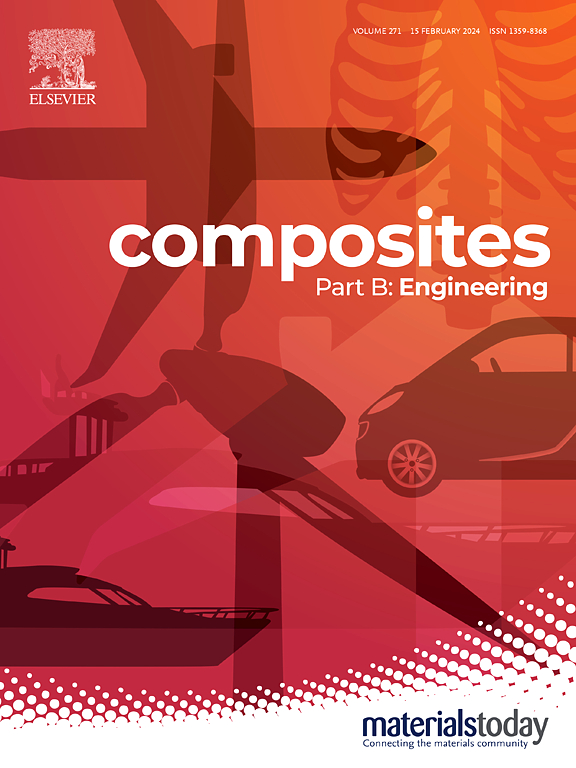Classification and prediction of flexural properties of bamboo slices made from flattened bamboo with a gradient structure based on GA-BP neural network model
IF 12.7
1区 材料科学
Q1 ENGINEERING, MULTIDISCIPLINARY
引用次数: 0
Abstract
Bamboo slices (BS) have been successfully used in bamboo winding composites due to their excellent flexural properties. However, BS with a gradient structure is prone to breakage easily during the winding process, particularly when varying thicknesses are involved. This study investigated flexural properties and size effects of BS, as well as prediction of their flexural properties. A mathematical relationship was established between fiber content of BS and its radial position, revealing an exponential decay function with an average fit quality of 0.9. The flexural strength, flexural modulus and radius of curvature of BS increased with higher fiber content. However, for BS with a thickness of 0.7 mm, the radius of curvature exhibited an inverse relationship with fiber content when the load was applied to the side of BS with fewer vascular bundles. Analysis indicated that BS with thicknesses of 0.3 mm and 0.5 mm can be considered homogeneous materials, while BS with a thickness of 0.7 mm retained the gradient structure and properties of bamboo culm wall. Additionally, BS showed a significant size effect, where thicker BS displayed lower strength due to defect effect, variation of length-thickness ratio and hoop effect. At last, a GA-BP neural network model was developed and validated as an effective tool for predicting BS flexural properties based on their radial position, achieving an accuracy of over 95 %. This study provides valuable insights into the flexural properties and size effects of BS, providing a scientific foundation and technical support for the development of bamboo winding products.
基于GA-BP神经网络模型的梯度平直竹片抗弯性能分类与预测
竹片由于其优异的抗弯性能,已成功地应用于竹缠绕复合材料中。然而,梯度结构的BS在缠绕过程中容易断裂,特别是在涉及不同厚度的情况下。本研究探讨了BS的抗弯性能和尺寸效应,并对其抗弯性能进行了预测。建立了BS纤维含量与其径向位置之间的数学关系,显示出指数衰减函数,平均拟合质量为0.9。随着纤维含量的增加,BS的抗弯强度、抗弯模量和曲率半径增大。然而,对于厚度为0.7 mm的BS,当载荷施加在维管束较少的BS一侧时,曲率半径与纤维含量呈反比关系。分析表明,厚度为0.3 mm和0.5 mm的竹材可以认为是均匀材料,而厚度为0.7 mm的竹材则保留了竹材壁的梯度结构和特性。此外,BS具有显著的尺寸效应,其中较厚的BS由于缺陷效应、长厚比的变化和箍效应而强度较低。最后,建立了GA-BP神经网络模型,并验证了该模型是基于BS径向位置预测其弯曲性能的有效工具,准确率超过95%。本研究为竹材缠绕材料的弯曲性能和尺寸效应提供了有价值的见解,为竹材缠绕产品的开发提供了科学依据和技术支持。
本文章由计算机程序翻译,如有差异,请以英文原文为准。
求助全文
约1分钟内获得全文
求助全文
来源期刊

Composites Part B: Engineering
工程技术-材料科学:复合
CiteScore
24.40
自引率
11.50%
发文量
784
审稿时长
21 days
期刊介绍:
Composites Part B: Engineering is a journal that publishes impactful research of high quality on composite materials. This research is supported by fundamental mechanics and materials science and engineering approaches. The targeted research can cover a wide range of length scales, ranging from nano to micro and meso, and even to the full product and structure level. The journal specifically focuses on engineering applications that involve high performance composites. These applications can range from low volume and high cost to high volume and low cost composite development.
The main goal of the journal is to provide a platform for the prompt publication of original and high quality research. The emphasis is on design, development, modeling, validation, and manufacturing of engineering details and concepts. The journal welcomes both basic research papers and proposals for review articles. Authors are encouraged to address challenges across various application areas. These areas include, but are not limited to, aerospace, automotive, and other surface transportation. The journal also covers energy-related applications, with a focus on renewable energy. Other application areas include infrastructure, off-shore and maritime projects, health care technology, and recreational products.
 求助内容:
求助内容: 应助结果提醒方式:
应助结果提醒方式:


